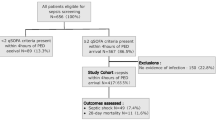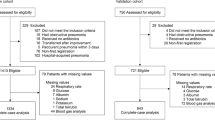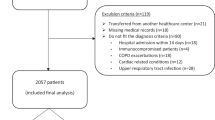Abstract
Objectives
Current risk stratification in community-acquired pneumonia (CAP) does not incorporate the dynamic nature of CAP evolution. Study aim was to evaluate the predictive value of early blood pressure (BP) drop and its consideration within the CRB-65 score.
Methods
We performed a retrospective cohort study including consecutive adult hospitalized CAP patients 2013–2014 without documented treatment limitations or direct ICU admission. The CRB-65 score was calculated initially and re-calculated including any BP below the threshold (BP drop) within the first 24 h (CRB-65[BP24]). The primary endpoint was need for mechanical ventilation or vasopressors (MVVS) occurring after 24 h. Prognostic values were evaluated by uni- and multivariate and ROC curve analyses.
Results
28/294 patients (9.5%) met the primary endpoint. Only 3 (11%) of them showed an initial BP of < 90 mmHg systolic or ≤ 60 mmHg diastolic, but 21 (75%) developed a BP drop within the first 24 h. 24/178 (13%) with and only 4/116 (3%) without any low BP during the first 24 h needed MVVS (p = 0.004). After multivariate analysis, the predictive value of BP drop was independent of other score parameters and biomarkers (all p < 0.01). In ROC analysis, the new CRB-65(BP24) showed a better prediction than the CRB-65 score (AUC 0.69 vs. 0.62, p = 0.04). 7/13 patients (54%) with MVVS despite an admission CRB-65 of 0 or 1 showed a BP drop.
Conclusions
In the evaluated cohort, BP drop within the first 24 h was significantly associated with more need for MVVS in CAP, and its consideration improved the prognostic value of the CRB-65 score.

Similar content being viewed by others
References
Page DB, Donnelly JP, Wang HE. Community-, healthcare-, and hospital-acquired severe sepsis hospitalizations in the University HealthSystem Consortium. Crit Care Med. 2015;43:1945–51.
Ewig S, Hoffken G, Kern WV, et al. Management of adult community-acquired pneumonia and prevention—update 2016. Pneumologie. 2016;70:151–200.
Woodhead M, Blasi F, Ewig S, et al. Guidelines for the management of adult lower respiratory tract infections–full version. Clin Microbiol Infect. 2011;17:E1–59.
Lim WS, van der Eerden MM, Laing R, et al. Defining community acquired pneumonia severity on presentation to hospital: an international derivation and validation study. Thorax. 2003;58:377–82.
Dremsizov T, Clermont G, Kellum JA, Kalassian KG, Fine MJ, Angus DC. Severe sepsis in community-acquired pneumonia: when does it happen, and do systemic inflammatory response syndrome criteria help predict course? Chest. 2006;129:968–78.
Aliberti S, Amir A, Peyrani P, et al. Incidence, etiology, timing, and risk factors for clinical failure in hospitalized patients with community-acquired pneumonia. Chest. 2008;134:955–62.
Rhodes A, Evans LE, Alhazzani W, et al. Surviving sepsis campaign: international guidelines for management of sepsis and septic shock: 2016. Intens Care Med. 2017;43:304–77.
Ewig S, Birkner N, Strauss R, et al. New perspectives on community-acquired pneumonia in 388,406 patients Results from a nationwide mandatory performance measurement programme in healthcare quality. Thorax. 2009;64:1062–9.
Carr GE, Yuen TC, McConville JF, et al. Early cardiac arrest in patients hospitalized with pneumonia: a report from the American Heart Association's Get with the Guidelines-Resuscitation Program. Chest. 2012;141:1528–36.
Quinten VM, van Meurs M, Ter Maaten JC, Ligtenberg JJ. Trends in vital signs and routine biomarkers in patients with sepsis during resuscitation in the emergency department: a prospective observational pilot study. BMJ Open. 2016;6:e009718.
Quinten VM, van Meurs M, Olgers TJ, Vonk JM, Ligtenberg JJM, Ter Maaten JC. Repeated vital sign measurements in the emergency department predict patient deterioration within 72 h: a prospective observational study. Scand J Trauma Resusc Emerg Med. 2018;26:57.
Grassi G, Bombelli M, Brambilla G, Trevano FQ, Dell'oro R, Mancia G. Total cardiovascular risk, blood pressure variability and adrenergic overdrive in hypertension: evidence, mechanisms and clinical implications. Curr Hypertens Rep. 2012;14:333–8.
Chalmers JD, Mandal P, Singanayagam A, et al. Severity assessment tools to guide ICU admission in community-acquired pneumonia: systematic review and meta-analysis. Intensive Care Med. 2011;37:1409–20.
Renaud B, Santin A, Coma E, et al. Association between timing of intensive care unit admission and outcomes for emergency department patients with community-acquired pneumonia. Crit Care Med. 2009;37:2867–74.
Phua J, Ngerng WJ, Lim TK. The impact of a delay in intensive care unit admission for community-acquired pneumonia. Eur Respir J. 2010;36:826–33.
Restrepo MI, Mortensen EM, Rello J, Brody J, Anzueto A. Late admission to the ICU in patients with community-acquired pneumonia is associated with higher mortality. Chest. 2010;137:552–7.
Kolditz M, Ewig S, Klapdor B, et al. Community-acquired pneumonia as medical emergency: predictors of early deterioration. Thorax. 2015;70:551–8.
Ewig S, Bauer T, Richter K, et al. Prediction of in-hospital death from community-acquired pneumonia by varying CRB-age groups. Eur Respir J. 2013;41:917–22.
Hanley JA, McNeil BJ. A method of comparing the areas under receiver operating characteristic curves derived from the same cases. Radiology. 1983;148:839–43.
Glickman SW, Cairns CB, Otero RM, et al. Disease progression in hemodynamically stable patients presenting to the emergency department with sepsis. Acad Emerg Med. 2010;17:383–90.
Lee YI, Smith RL, Gartshteyn Y, Kwon S, Caraher EJ, Nolan A. Predictors of acute hemodynamic decompensation in early sepsis: an observational study. J Clin Med Res. 2016;8:575–81.
Williams B, Mancia G, Spiering W, et al. 2018 ESC/ESH Guidelines for the management of arterial hypertension: the Task Force for the management of arterial hypertension of the European Society of Cardiology and the European Society of Hypertension: The Task Force for the management of arterial hypertension of the European Society of Cardiology and the European Society of Hypertension. J Hypertens. 2018;36:1953–2041.
Lacruz ME, Kluttig A, Kuss O, et al. Short-term blood pressure variability—variation between arm side, body position and successive measurements: a population-based cohort study. BMC Cardiovasc Disord. 2017;17:31.
Fine MJ, Auble TE, Yealy DM, et al. A prediction rule to identify low-risk patients with community-acquired pneumonia. N Engl J Med. 1997;336:243–50.
Lim HF, Phua J, Mukhopadhyay A, et al. IDSA/ATS minor criteria aid pre-intensive care unit resuscitation in severe community-acquired pneumonia. Eur Respir J. 2014;43:852–62.
Goulden R, Hoyle MC, Monis J, et al. qSOFA, SIRS and NEWS for predicting inhospital mortality and ICU admission in emergency admissions treated as sepsis. Emerg Med J. 2018;35:345–9.
Singer M, Deutschman CS, Seymour CW, et al. The third international consensus definitions for sepsis and septic shock (Sepsis-3). JAMA. 2016;315:801–10.
Guo Q, Li HY, Li YM, et al. Compliance with severe sepsis bundles and its effect on patient outcomes of severe community-acquired pneumonia in a limited resources country. Arch Med Sci. 2014;10:970–8.
Kolditz M, Ewig S, Hoffken G. Management-based risk prediction in community-acquired pneumonia by scores and biomarkers. Eur Respir J. 2013;41:974–84.
Funding
There was no external funding for the presented work.
Author information
Authors and Affiliations
Contributions
Conception, hypothesis, and design of the study: MK, NM, and BSH; acquisition of data: NM and UK; analysis and interpretation: BSH, MK, NM and UK; substantial involvement in the writing and revision of the article: BSH, MK, NM and UK; manuscript’s guarantor: MK.
Corresponding author
Ethics declarations
Conflict of interest
The authors declare that there is no conflict of interest regarding the publication of this article.
Electronic supplementary material
Below is the link to the electronic supplementary material.
Rights and permissions
About this article
Cite this article
Schulte-Hubbert, B., Meiswinkel, N., Kutschan, U. et al. Prognostic value of blood pressure drops during the first 24 h after hospital admission for risk stratification of community-acquired pneumonia: a retrospective cohort study. Infection 48, 267–274 (2020). https://doi.org/10.1007/s15010-020-01391-x
Received:
Accepted:
Published:
Issue Date:
DOI: https://doi.org/10.1007/s15010-020-01391-x




